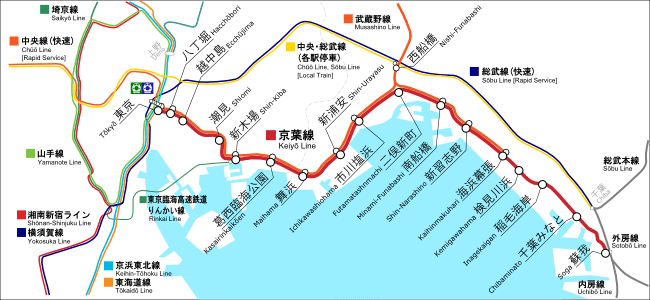The JR Keiyo Line, or Keiyo-sen, is one of Japan’s many railway systems operated by the East Japan Railway Company, or JR East. The Keiyo Line first opened in 1975. Over 700,000 passengers utilize this railway line each day.
Did you know? The name “Keiyo” is derived from the names of the terminus stations that are linked by the line, Tokyo and Chiba.
Trains are a safe, efficient, and remarkable way to travel around Japan. As an international traveler, you will be able to purchase a Japan Rail Pass, also known as a JR Pass. If you will be traveling in and around Tokyo, you may find yourself on board the Keiyo Line, which connects Tokyo to Chiba, the capital city of the Chiba prefecture.
Use this handy guide to plan your travels and learn how to utilize the JR Keiyo Line, fully covered by your JR Pass.
Table of Contents
JR Keiyo line stations
The JR Keiyo Line is 43 kilometers or 27 miles in length. Portions of the line are underground or elevated. Together with the Yokohama Line, Nambu Line, and Musashino Line, it is part of the Tokyo Mega Loop.
The eighteen stations along the JR Keiyo line include:
- Tokyo Station
- Hatchobori Station
- Etchujima Station
- Shiomi Station
- Shin-Kiba Station
- Kasai-Rinkai Park Station
- Maihama Station
- Shin-Urayasu Station
- Ichikawashiohama Station
- Nishi-Funabashi Station
- Futamatashimmachi Station
- Minami-Funabashi Station
- Shin-Narashino Station
- Keihimmakuhari Station
- Kemigawahama Station
- Inagekaigan Station
- Chibaminato Station
- Soga Station
Please note that the Keiyo Line should not be confused with the Keio Line, a privately operated line on the west side of Tokyo.
JR East’s new station development plan includes additional station construction between Shin-Narashino Station and Kihimmakuhari Station. Proposed names for this new station are yet to be announced.
JR Keiyo line services
The JR Keiyo Line is considered a commuter rail service, meaning it connects the metropolitan area to adjacent suburbs and towns. The trains on this line are primarily local trains, operating at slower speeds than the famed Shinkansen bullet trains. The average operating speed along the Keiyo Line is 100 kilometers or 60 miles per hour.
There are four types of services that operate on the JR Keiyo Line:
- The Keiyo Line Local, or kakueki-teisha, trains stop at all Keiyo Line stations with the exception of Nishi-Funabashi Station.
- Musashino Line Local trains stop at all Keiyo Line stations between Tokyo Station and Nishi-Funabashi Station, before diverging onto the Musashino Line.
- Keiyo Line Rapid, or kaisoku, trains make a limited number of stops, shortening the length of the trip between Tokyo Station and Soba Station. The Commuter Rapid Service, or tsukin-kaisoku, trains stop only at Tokyo, Hatchobori, Shin-Kiba, and Soga Stations.
JR Keiyo line map
The JR Keiyo Line runs parallel to the edge of Tokyo Bay, extending eastward from Tokyo. Please see the accompanying map to aid in planning your journey.

Things to do along the JR Keiyo line
Tokyo itself is a must-visit destination for many travelers. This “neon city” never sleeps, and holds something special for travelers of every taste. There are shopping districts, museums, beautiful urban parks, unique eateries, cosplay and anime districts, and much more.
Tokyo Station itself also serves as a departure point for regions all across Japan. It’s also a great place to spend a few hours. Have lunch at one of the many izakayas (Japanese-style pubs) or restaurants of Kitchen Street and Ramen Street. Then, visit Character Street to pick up some souvenirs. All this can be done from within the depths of Tokyo Station!
The JR Keiyo Line is the primary access point for the Tokyo Disney Resort, located east of Tokyo. Tokyo Disneyland has been called the “holy grail” of all the Disney parks around the world. Themed areas include the World Bazaar, Adventureland, Westernland, Critter Country, Fantasyland, Toontown, and Tomorrowland. The Resort also includes Tokyo DisneySea, a water-bound theme park with areas such as Mediterranean Harbor, the Mysterious Island, Mermaid Lagoon, Arabian Coast, Lost River Delta, Port Discovery, and the American Waterfront, and Ikspiari, a shopping district similar to the Downtown Disney or Disney Springs found at other Disney parks.

The JR Keiyo Line can also be used to access the Makuhari Messe convention center, home to trade shows and events like the official Pokémon Trading Card Game tournament, Star Wars Celebration, and musical concerts.
What are you waiting for? Planning your next trip to Japan is as easy as can be, especially with a JR Pass in hand. Start discovering your next adventure today!
